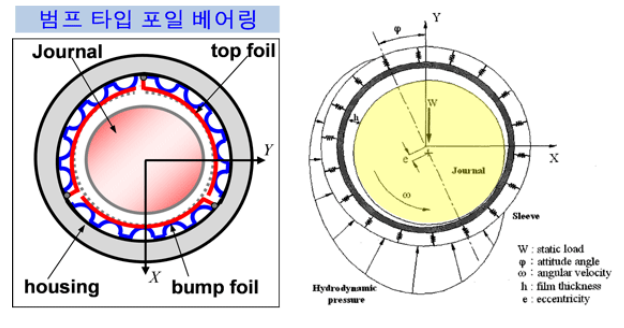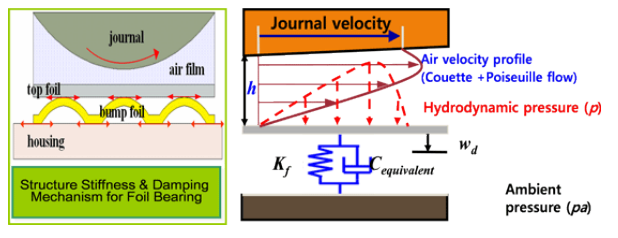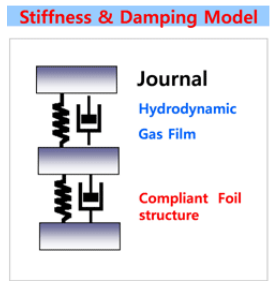MEDVIC 연구실
MEchanical Design and VIbration Control
Research
- HOME
- Research
- Gas Foil Bearing
Gas Foil Bearing
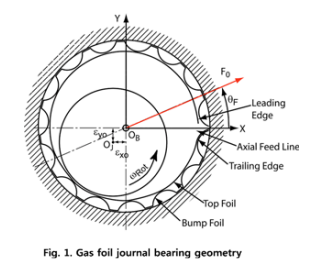
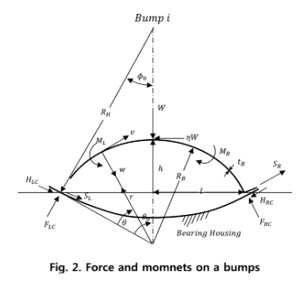
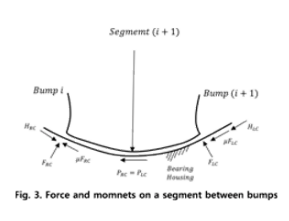
Implementing gas foil bearings in turbo-machinery reduces system complexity and maintenance costs, and increases efficiency and operating life. However, a lack of analytical models to predict the dynamic characteristics of GFBs forces the bearing designer to rely on prototype testing, which is time-consuming and expensive. So it is important to present a theoretical model to predict the structural stiffness and damping coefficients of the bump foil strip in a journal bearing or damper. Stiffness is calculated based on the perturbation of the journal center with respect to its static equilibrium position. The equivalent viscous damping coefficients are determined based on the area of a closed hysteresis loop of the journal center motion.
"Gas foil bearing - bump types"
Fig. 4. Schematic views of gas foil bearing
There is a widespread usage of gas foil bearings into microturbomachinery to midsize gas turbine engines. Gas foil bearing can makes various effects, such as reduces system complexity, maintenance costs, increases efficiency and operating life. The hydrodynamic wedge will makes a hydrodynamic pressure field. This pressure field and air film can change the status about the shaft to lift to the center of the bearing.
Fig. 5. the mechanism of the bump-type gas foil bearing
The elastic foil structure inside of the bearing can makes a widely minimum gas film zone than the other bearing. The thin foil of smooth surface is supported by a series of bump foils acting as springs, thus making the bearing compliant. It makes a fiction damping. It described a hydrodynamic film pressure and a flows builds up within the small gap between the rotating shaft and the smooth foil. The flow is Poiseuille flow and couette flow. Simplified modeling about the hydrodynamic gas film and the compliant foil structure. All the rotordynamic behavior depends on the mechanism between the hydrodynamic gas film and the compliant foil structure.
Fig. 6. the mechanism of the bump-type gas foil bearing
Fig. 7. Static and dynamic characteristics of the gas foil bearing
Gas foil bearing’s stiffness and damping(dynamic characteristic) is lower than the other type of bearings. In general, Before the design, designer have to know about the static and dynamic characteristics rages. It will support to improve the rotordynamic performances.
"Foil thrust bearing & mechanical structure analysis and Vibration monitoring"
the research includes optimization of foil thrust bearing through FEM & FDM analysis. The foil thrust bearing is designed to have an optimum load capacity and inclined angle, film thickness, stiffness, viscosity and rotating speed which has an effect on bearing number is considered by analysis. This paper use the Reynolds equation to predict the performance of the foil thrust bearing and the analysis program is modified to analysis the load capacity with various conditions.
structural analysis through 3D FEM program is conducted in the MEDVIC lab. For example, stiffness and deformation of pivot in tilting pad bearing was predicted by FEM analysis and compared with Herzian pivot model. On the basis of this, it is possible to consider various pivot design for tilting pad bearing.
MEDVIC can conduct vibration monitoring and analysis using DAQ board and sensor system. MEDVIC can predict static or operating problems through vibration analysis.

